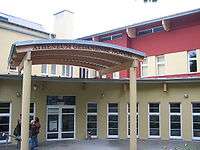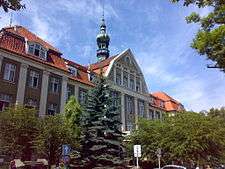Gdańsk Medical University
| Gdański Uniwersytet Medyczny | |
|
Faculty of Pharmacy of Gdańsk Medical University. | |
| Latin: Universitas Medica Gedanensis | |
| Established | October 8th, 1945 |
|---|---|
| Chancellor | Mgr. Marek Langowski |
Administrative staff | 1657 |
| Students | 6171 |
| 176 | |
| Location |
Gdańsk, |
| Campus | Urban |
| Affiliations | ERASMUS programme |
| Website | mug.edu.pl |
 MUG Atheneum Gendanense Novum building MUG Atheneum Gendanense Novum building | |
The Medical University of Gdańsk is the largest medical academic institution in northern Poland. It educates more than 5000 undergraduate and postgraduate students in four faculties.
History
The Akademia Lekarska in Gdańsk was founded on 8 October 1945. Its history is related to the tradition of medical practice of surgeons associated in the Surgeons Guild (active since 1454), as well as teaching and medical and scientific research, particularly in Gdańskie Gimnazjum Akademickie (Atheneum Gedanese) established in 1558. This institution set up the Department of Science and Medicine (physices et medicinae), which was managed and supervised by eminent scholars. Among the most famous lecturers were: Joachim Oelhafius, a native of Gdańsk, who in 1613 was the first to perform a public autopsy of a newborn child in northern Europe, and Dr Jan Adam Kulmus, the author of the anatomical atlas Tabulae anatomicae, published in 1932. The work went into several editions and was translated into many languages. The Gimnazjum Akademickie represented a high standard of achievement and its graduates were accepted in the third year of medical studies at universities in western Europe. After the closing of the Gimnazjum Akademickie at the beginning of the 19th century, it was not until the first years of the 20th century that another academic school was established.
Pharmaceutical sciences in Gdańsk date back to the times of Johannes Placotomus, author and founder of the first pharmacy in Gdańsk in 1527, and Johannes Schmiedt, alias Fabritius, the co-author of the oldest Polish pharmacopoeia, published in 1665.

In 1935 the Gdańsk Senate, already represented mostly by German nationalists (members of the NSDAP) went about establishing Akademia Medycyny Praktycznej (Die Staatliche Akademie für Praktische Medizin zu Danzig) on the basis of the municipal hospital built between 1907 and 1911. Teaching medicine in the newly opened college involved clinical courses. In 1940, following the introduction of pre-clinical courses, the college’s name was changed to Medizinische Akademie in Danzig, offering full 5-year medical studies.
After the end of World War II, Akademia Lekarska was founded in Gdańsk. In 1950 its name was changed to Akademia Medyczna (The Medical University of Gdańsk). Among the professors of the newly established college, there were many eminent Polish scholars from the University of Stefan Batory in Vilnius, who had come to Gdańsk after Vilnius was incorporated into the Soviet Union, and a handful of scholars from other pre-war Polish academic centers. Initially, Akademia Lekarska conducted studies in two majors: medical and pharmaceutical. In May 1947 the Faculty of Stomatology was created and later on in January 1950 the name was changed to the Subfaculty of Dentistry at the Faculty of Medicine. In 1975 Medical University of Gdańsk (MUG) opened a branch in Bydgoszcz, which in 1984 became an independent college. In 1993, as a joint unit of Medical University of Gdańsk and Gdańsk University, the Intercollegiate Faculty of Biotechnology was founded. In the academic year 2005/2006 Medical University started the Faculty of Health Sciences.
Faculties
The faculties are:
- Faculty of Health Sciences
- Faculty of Medicine
- Faculty of Pharmacy
- The Intercollegiate Faculty of Biotechnology of the University of Gdańsk and the Medical University of Gdańsk.
Teaching activities are carried out by nearly one thousand of academic teachers, with over one hundred of them holding the professor position. Currently, MUG offers education in nearly all medical professions and classes are also conducted in English. This programme is called English Division of the Faculty of Medicine.
Research
Aside from the educational activity, the MUG focuses on scientific research. It scored highly in the ranking of the Polish Ministry of Science and Higher Education. The Award of the Foundation for Polish Science was received by Professor Roman Kaliszan in 2003 and Professor Janusz Limon in 2004.
When the ranking system of the Ministry of Science and Higher Education was established, the Medical University of Gdańsk introduced an internal system of parametric assessment of particular research units. Today, three faculties of the MUG – Medicine, Pharmacy, and the Intercollegiate Faculty of Biotechnology have top positions in the ranking, as does the unique Interdepartmental Institute of Maritime and Tropical Medicine. The Faculty of Health Sciences, founded in 2006, is preparing for the parametric assessment of the Ministry of Science and Higher Education and it has also submitted an application to be granted the right to award PhD degrees.
The main funding sources for research are: statutory activity (118 research topics), commissioned projects, development projects, own projects, promoter projects, post doctorate projects (altogether 109 projects), own research (345 research topics), and research support activity (37 projects). Moreover, the academic teachers perform scientific research under contract with external entities, primarily with pharmaceutical enterprises (19 service and research projects). The University staff also carries out projects financed by the EU framework programmes and other community initiatives, as well as structural funds, including the Sector Operational Programme –Increased Enterprise Competition.
The high level of research work and the highest qualifications of our academic teaching staff are reflected in individual distinctions, among many – the Polish Nobel Prizes – the prize awarded by the Foundation for Polish Science to professors: Roman Kaliszan in 2003 and Janusz Limon in 2004. In the previous academic year the Prime Minister gave the award for scientific activity to professor Jacek Jassem and post doctorate teacher Michał Markuszewski was the laureate of the prestigious academic scholarship of the Minister of Science and Higher Education. The scholarship was addressed to eminent young scientists in the category of research for the sake of scientific development.
Developments
Many new research institutes and clinics have been established, the equipment has been modernized, new facilities have been created and all the buildings including the campus have been equipped with computers and a computer network. In 2007 the modernization of the main teaching hospital, Academic Clinical Centre was launched. The investment is co-financed by the state budget with the subsidy of 480 million Polish zlotys.
International links
The university cooperates with more than 50 universities and scientific centers abroad. It exchanges students and teachers in the framework of the Lifelong Learning Programme and is an active member of many European organizations and institutions. It is a founding member of two regional organizations: ScanBalt and the Baltic Sea Region University Network.
Clinical mission
Aside from fulfilling its teaching and research roles, the Medical University is the founding body of four health care institutes, including two clinical hospitals: the University Clinical Centre – the MUG Hospital and the Institute of Maritime and Tropical Medicine. Their significance for the health care system is shown in the number of hospitalized patients (almost 60,000), outpatient visits (over 250,000), surgery procedures (over 21,000, including about 1,500 open-heart surgeries) and laboratory tests (over 2 million a year). The clinical hospitals offer medical treatments unavailable anywhere else in Northern Poland, such as: organ transplants (kidneys, bone marrow and heart), radiotherapy and oncological chemotherapy, child and adult hematology, invasive cardiology and electro-cardiology, organ surgery, hyperbaric medicine, tropical and nuclear medicine.
The Medical University of Gdańsk and its hospitals operate locally, as well as outside the region. As a result, they cater for the health and security of around 3.5 million Poles.
Cooperation
The Medical University of Gdańsk provides health care for the people of Pomerania and inhabitants of neighboring regions, as the founder of clinical hospitals and other health-care facilities.
It undertakes expert work for the public authorities, for example in the Health for Pomerania Programme, which aims at health improvement for the inhabitants of the region. The university is actively involved in work on the Strategy of Pomeranian Voivodship Development, Regional Innovation Strategy and the Pomeranian Voivodship Regional Operational Programme.
The university's initiatives for the community spread awareness of preventive treatment and a healthy lifestyle, e.g. Good Health Picnic (Piknik na Zdrowie) and the local implementation of large-scale prophylaxis programmes, e.g. The 400 Cities Programme. The University actively participates in the Baltic Science Festival.
External links
- Medical University of Gdańsk
- Medical University of Gdańsk Canadian and U.S. recruitment office
- MUG English Division Students' Website
- Institutions affiliated with MUG
- ScanBalt
- Baltic Sea Region Universities Network
Coordinates: 54°21′58″N 18°37′50″E / 54.36611°N 18.63056°E